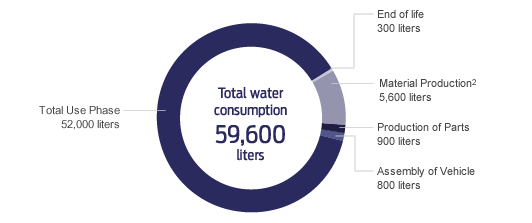Water Consumption in the Vehicle Lifecycle
To better assess our water-related impacts, we have been working to quantify water consumption over the life of a typical light-duty vehicle in the U.S. The Georgia Institute of Technology’s Sustainable Design and Manufacturing program conducted a literature survey and analysis that included water used in material production, production of parts, vehicle assembly, vehicle use (fuel production and distribution) and vehicle disposal at end-of-life. Georgia Tech has also worked with Ford on a number of other multidisciplinary issues related to sustainable development.
The analysis found that the greatest water consumption occurs during the use phase, when consumers are driving. This is largely due to the amounts of water required for fuel production. In the supply chain, the production and processing of metals (in particular steel and aluminum) require the most water. Identifying which portions of the supply chain are most water-intensive allows us to better assess the business risk associated with using suppliers in potentially water-stressed areas.
Estimation of water use in the lifecycle of a vehicle is a difficult task because of incomplete data sets, as well as non-standardized definitions (e.g., for “water use” and “water consumption”) used in earlier studies. Although water use is typically metered at the factory level, water consumption (i.e., water lost through evaporation and/or incorporation into a material, part and/or product) is much harder to quantify and requires data on water discharge in addition to water input. The Georgia Tech study was based on the average vehicle composition from an older study that did not fully reflect the material composition of current vehicles. We view the latest data as preliminary, but directionally correct. We are working to gain a better understanding of water use and consumption in all aspects of the vehicle lifecycle (including alternative fuels such as biofuels and new vehicle technologies such as electric vehicles) and plan to report updated assessments in the future.
Lifecycle Water Consumption1

| Stage | Approximate Water Consumption (Liters) | Percentage |
|---|---|---|
| Total | 59,600 | 100% |
| Material Production2 | 5,600 | 9% |
| Production of Parts | 900 | 1.5% |
| Assembly of Vehicle | 800 | 1.3% |
| Total Use Phase | 52,000 | 87% |
| End of Life | 300 | 0.5% |
Notes to Data
- Source: B. Bras, F. Tejada, J. Yen, J. Zullo, T. Guldberg, Quantifying the Life Cycle Water Consumption of a Passenger Vehicle, SAE Technical Paper 2012-01-0646.
- Indirect, upstream water consumptions were not included in the material production stage.
Water Consumption = Freshwater withdrawals that are evaporated or incorporated in products and waste.
Water Use = All water that goes into a system. Most of this typically leaves the system as wastewater.










